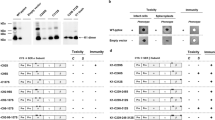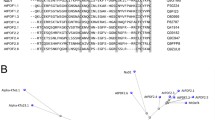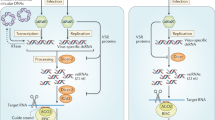Abstract
Several strains of Ustilago maydis (corn smut fungus) and Saccharomyces cerevisiae (yeast) have been classified as “killer strains” by their ability to kill similar strains of fungi in culture. This killer phenotype is due to secretion of toxins produced by dsRNA virions that persistently infect the host cell. The fungal toxins do not affect the host cell strain but do kill similar strains of fungi in that locale. These fungal viruses are unusual in that they are not expressed externally but instead are transmitted vertically through basidiospores or horizontally through anastomosis.1,2 Therefore, unlike most nonfungal viruses, the killer dsRNA fungal viruses have a symbiotic relationship with their host. The viruses are solely dependent upon host cell survival for replication and lend the host a selective advantage by encoding small toxins that are secreted by the host cell.
Access this chapter
Tax calculation will be finalised at checkout
Purchases are for personal use only
Preview
Unable to display preview. Download preview PDF.
Similar content being viewed by others
References
Bevan EA, Mankower M. The physiological basis of the killer character in yeast. Proc Int Congr Genet 1963; XI: 1202–03.
Wood HA, Bozarth RF. Heterokaryon transfer of viruslike particles and a cytoplasmically inherited determinant in Ustilago maydis. Phytopathology 1973; 63: 1019–21.
Bozarth RF, Koltin Y, Weissman MB et al. The molecular weight and packaging of dsRNAs in the mycovirus from Ustilago maydis killer strains. Virology 1981; 113: 492–502.
Cheng RH, Caston JR, Wang G et al. Fungal virus capsids: cytoplasmic compartments for the replication of double-stranded RNA formed as icosahedral shells of asymmetric Gag dimers. J Mol Biol 1994; 244: 255–58.
Esteban R, Wickner RB. Three different M1 RNA-containing viruslike particle types in Saccharomyces cerevisiae: in-vitro M1 double stranded RNA synthesis. Mol Cell Biol 1986; 6: 1552–61.
Fujimura T, Ribas JC, Makhov AM et al. Pol of gag-pol fusion protein required for encapsidation of viral RNA of yeast L-A virus. Nature 1992; 359: 746–49.
Caspar DLD, Klug A. Physical principles in the construction of regular viruses. Cold Spring Harbor Symp Quant Biol 1962; 27: 1–24.
Dryden KA, Wang G-J, Yeager MA et al. Early steps in reovirus infection are associated with dramatic changes in supramolecular structure and protein conformation: Analysis of virions and subviral particles by cryoelectron microscopy and three-dimensional image reconstruction. J Cell Biol 1993; 122: 1023–41.
Mansell EA, Patton JT. Rotavirus RNA replication: VP2, but not VP6, is necessary for viral replicase activity. J Virol 1990; 64: 4988–96.
Mindich M, Bamford DH. In Calendar R, ed. The Bacteriophages. Plenum Press, New York, 1988: 475–520.
Young TW, Yagiu M. A comparison of the killer character in different yeasts and its classification. Antonie van Leeuwenhoek 1978; 44: 59–77.
Bostian KA, Elliot Q, Bussey H et al. Sequence of the preprotoxin dsRNA gene of type 1 killer yeast: multiple processing produces a two component toxin. Cell 1984; 36: 741–51.
Bussey H, Boone C, Zhu H et al. Genetic and molecular approaches to synthesis and action of the yeast killer toxin. Experientia 1990; 46: 193–200.
Bussey H, Saville D, Greene DJ et al. Secretion of Saccaromyces cerevisiae killer toxin: processing of the glycosylated precursor. Mol Cell Biol 1983; 3: 1362–70.
Dimochowska A, Dignard D, Henning D et al. Yeast KEX1 gene encodes a putative protease with a carboxypeptidase B-like function involved in the killer toxin and a-factor precursor processing. Cell 1987; 50: 573–84.
Tipper DJ, Bostian KA. Double-stranded ribonucleic acid killer systems in yeast. Microbiol Rev 1984; 48: 125–56.
Bussey H. Physiology of killer factor in yeast. Adv Microb Physiol 1981; 22: 93–122.
De La Pena P, Barros F, Gascon S et al. Effect of yeast killer toxin on sensitive cells of Saccharomyces cerevisiae. J Biol Chem 1981; 256: 10420–25.
Middelbeek EJ, Von De Larr HHAM et al. Physiological conditions affecting the stability of Saccharonyces cerevisiae killer toxin and energy reqirement for toxin action. Antonie van Leeuwenhoek 1980; 46: 483–97.
Martinac B, Zhu H, Kubalski A et al. Yeast K1 killer toxin forms ion channels in sensitive yeast spheroplasts and in artificial liposomes. Proc Natl Acad Sci USA 1990; 87: 6228–32.
Kagan B. Mode of action of yeast killer toxins: channel formation in lipid bilayer membranes. Nature 1983; 302: 709–11.
Koltin Y. The killer system of Ustilago maydis: secreted polypeptides encoded by viruses. In: Koltin Y, Leibowitz M, eds. Viruses of Fungi and simple eukaryotes. New York: Marcel Dekker, 1988; 209–42.
Koltin Y, Day PR. Specifity of Ustilago maydis killer proteins. Applied Microbiol 1975; 30: 694–96.
Puhalla JE. Compatibility reactions on solid medium and interstrain inhibition in Ustilago maydis. Genetics 1968; 60: 461–74.
Peery T, Shabat-Brand T, Steinlauf R et al. The virus encoded toxin of Ustilago maydis-two polypeptides are essential for activity. Mol Cell Biol 1987; 7: 470–77.
Steinlauf R, Peery T, Koltin Y et al. The Ustilago maydis virus encoded toxin-effect of KP6 on cells and spheroplasts. Exp Mycol 1988; 12: 264–74.
Tao J, Ginzberg I, Banerjee N et al. Ustilago maydis KP6 toxin: structure, expression in Saccharonyces cerevisiae, and relationship to other cellular toxins. Mol Cell Biol 1990; 10: 1373–81.
Zizi M, Finkler A, Koltin Y. Association of both subunits of Ustilago maydis toxin, KP6, forms large voltage-independent channels. In: Bloomfield V, ed. Biophysical Society Meeting. San Francisco: Biophysical Journal, 1985: A203.
Duax WL, Ghosh D, Langs D et al. Crystallization of the cc polypeptide for the KP6 killer toxin. In: Bloomfield V, ed. Biophysical Society Meeting. Biophysical Journal, San Francisco, California, 1995; A203.
Bussey H. Effects of yeast killer factor on sensitive cells. Nature New Biology 1972; 235: 73–5.
Levine R, Koltin Y, Kandel J. Nuclease activity associated with the Ustilago maydis virus induced killer proteins. Nucleic Acids Research 1979; 6: 3717–32.
Ganesa C, Chang Y-H, Flurkey WH et al. Purification and molecular properties of the toxin coded by Ustilago maydis virus P4. Biophys Biochem Res Commun 1989; 162: 651–57.
Gu F, Khimani A, Rane SG et al. Structure and function of a virally encoded fungal toxin from Ustilago maydis: a fungal and mammalian Cat’ channel inhibitor. Structure 1995; 3: 805–14.
Orengo CA, Thornton JM. Alpha plus beta folds revisited: some favoured motifs. Structure 1993; 1: 105–20.
Achari A, Hale SP, Howard AJ et al. 1.67 A X-ray structure of the B2 immunoglobulin domain of streptococcal protein G and comparison to the NMR structure of the B1 domain. Biochemistry 1992; 31: 10449–57.
Derrick JP, Wigley DB. Crystal structure of a streptococcal protein G domain bound to an Fab fragment. Nature 1992; 359: 752–54.
Vijay-Kumar S, Bugg CE, Wilkinson KD et al. Comparison of the three-dimensional structures of human, yeast, and oat ubiquitin. J Biol Chem 1987; 262: 6396–99.
Fontecilla-Camps JC, Almassy RJ, Ealick SE et al. Architecture of scorpion neurotoxins: a class of membrane-binding proteins. Trends Biochem Soc 1981; 6: 291–96.
Housset D, Habersetzer-Rochat C, Astier J-P et al. Crystal structure of Toxin II from scorpion Androctonus australis hector refined at 1.3 A resolution. J Mol Biol 1994; 238: 88–104.
Fontecilla-Camps J-C. Three-dimensional model of the insect-directed scorpion toxin from Androctonus australis Hector and its implication for the evolution of scorpion toxins in general. J Mol Evol 1989; 29: 63–67.
Sampieri F, Habersetzer-Rochat C. Structure-function relationships in scorpion neurotoxins: identification of the superreactive lysine in toxin I of Androctonus australis Hector. Biochim Biophys Acta 1978; 535: 100–109.
Matteson DR, Armstrong CM. Properties of two types of calcium channels in clonal pituitary cells. J Gen Physiol 1986; 87: 161–82.
Artalejo CR, Mogul DJ, Perlman RL et al. Three types of bovine chromaffin cell Cal’ channels: facilitation increases the opening probability of a 27 pS channel. J Physiol 1991; 444: 213–40.
Smith TJ. MolView: a program to analyze and display atomic structures on the Macintosh personal computer. J Molecular Graphics 1995; 13: 122–25.
Rights and permissions
Copyright information
© 1996 Springer-Verlag Berlin Heidelberg
About this chapter
Cite this chapter
Gu, F., Khimani, A., Rane, S., Flurkey, W.H., Bozarth, R.F., Smith, T.J. (1996). The Structure of a Virally Encoded Fungal Toxin from Ustilago Maydis that Inhibits Fungal and Mammalian Calcium Channels. In: Protein Toxin Structure. Molecular Biology Intelligence Unit. Springer, Berlin, Heidelberg. https://doi.org/10.1007/978-3-662-22352-9_15
Download citation
DOI: https://doi.org/10.1007/978-3-662-22352-9_15
Publisher Name: Springer, Berlin, Heidelberg
Print ISBN: 978-3-662-22354-3
Online ISBN: 978-3-662-22352-9
eBook Packages: Springer Book Archive




